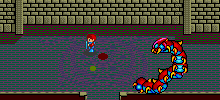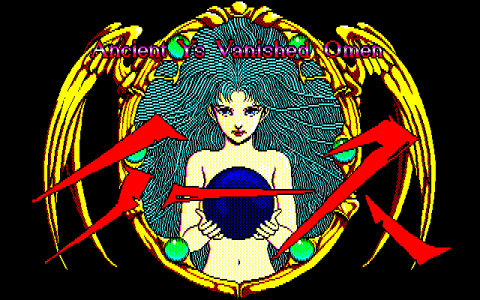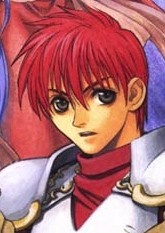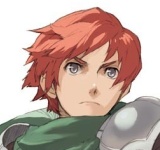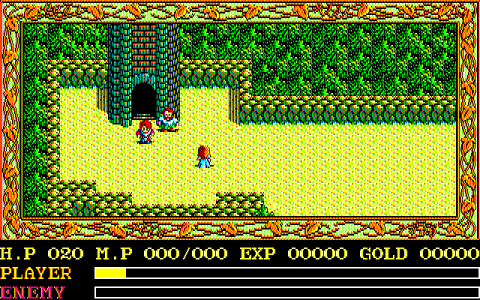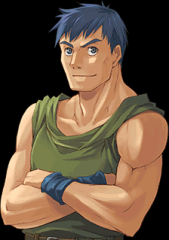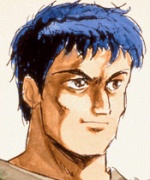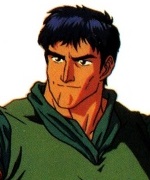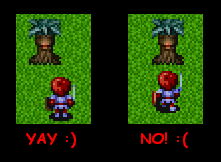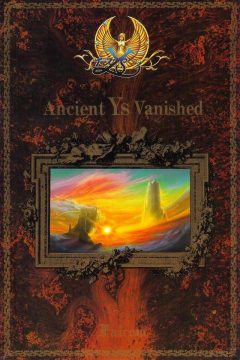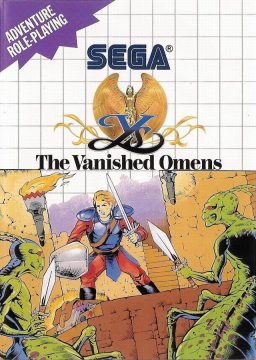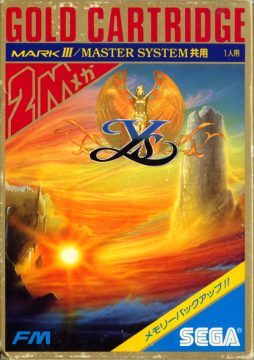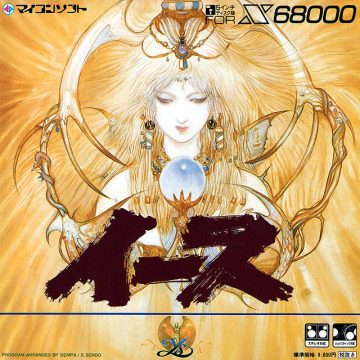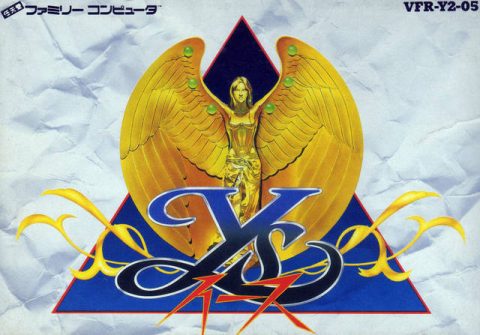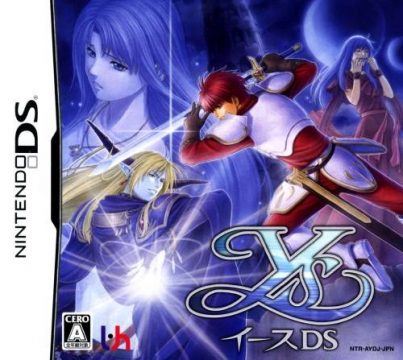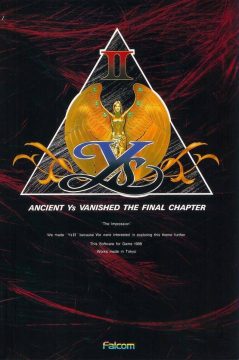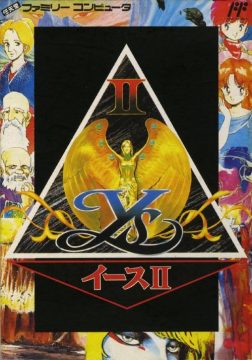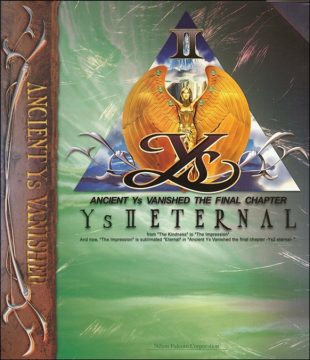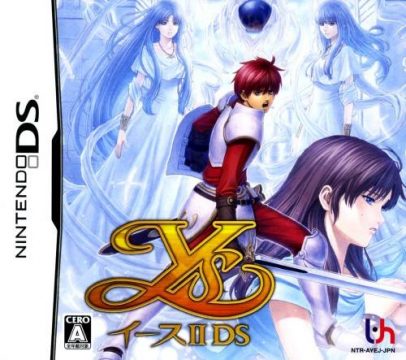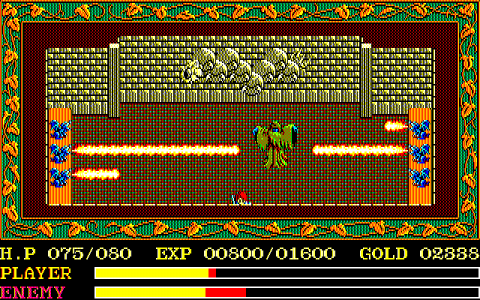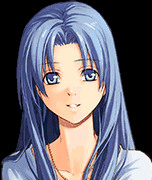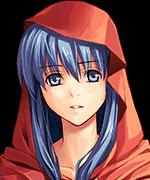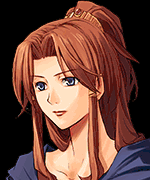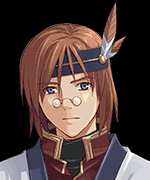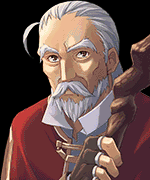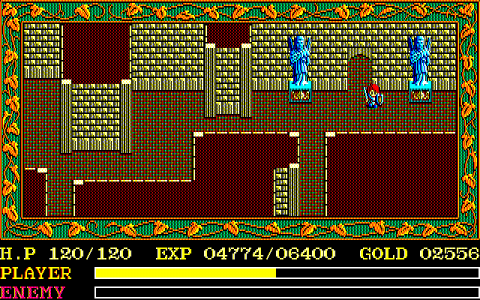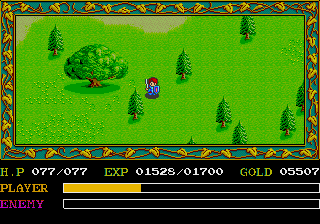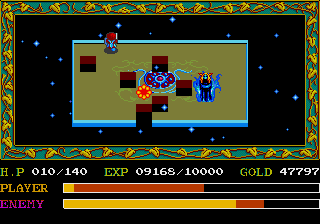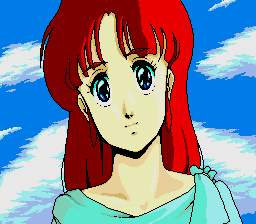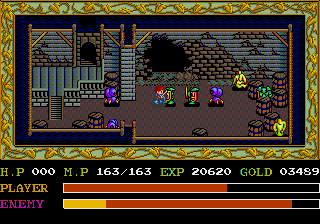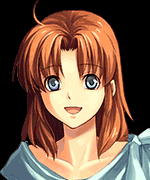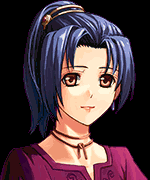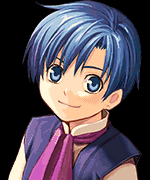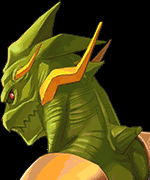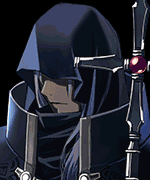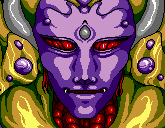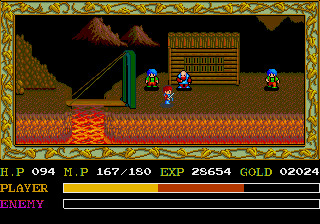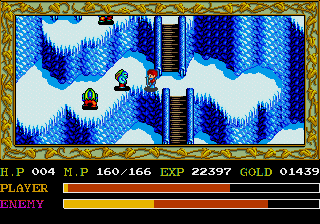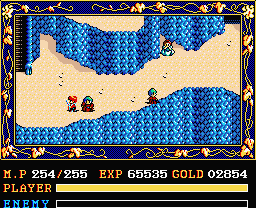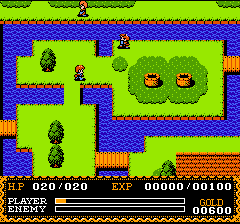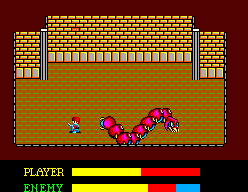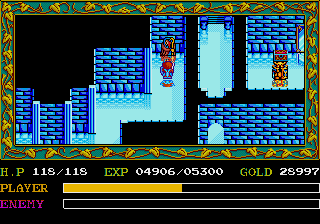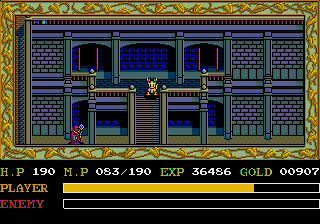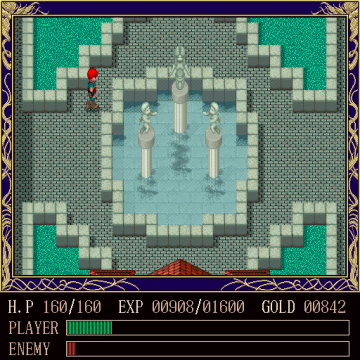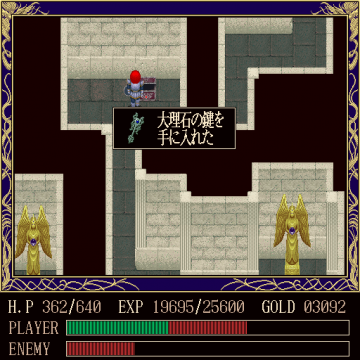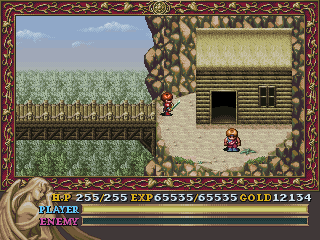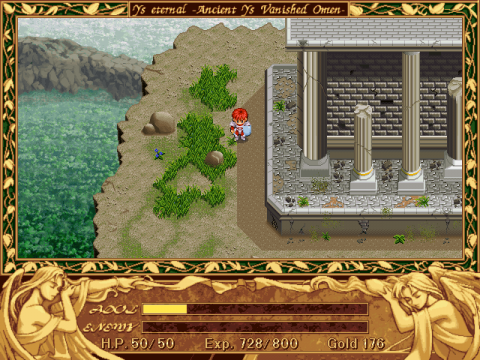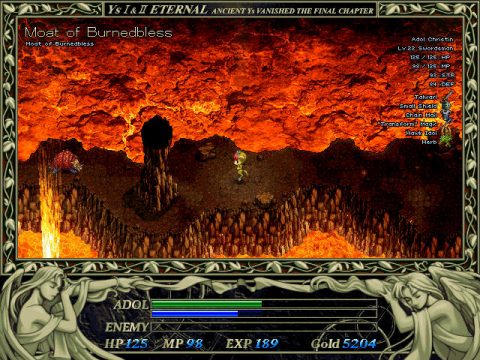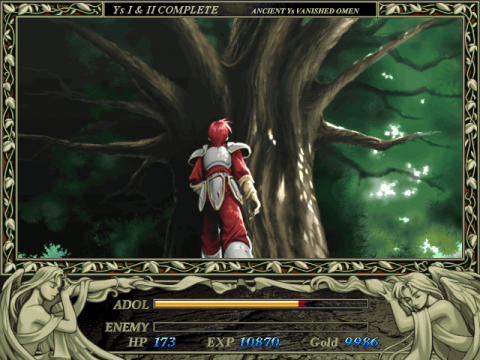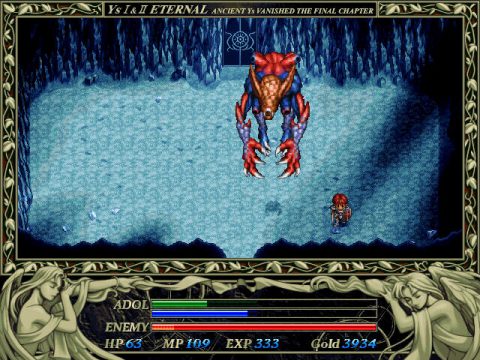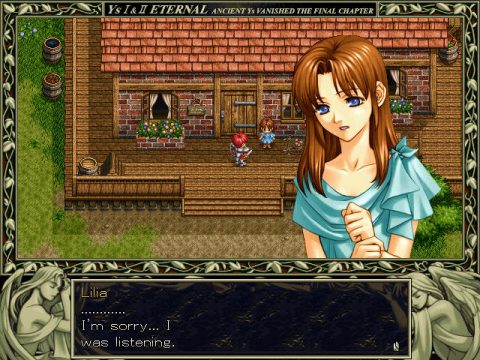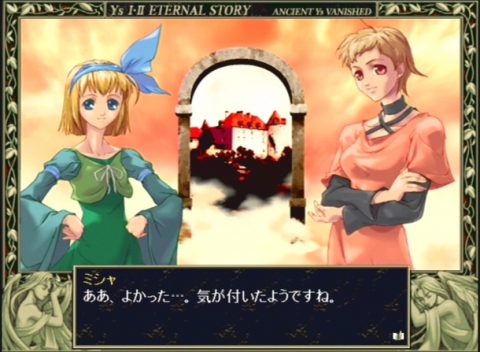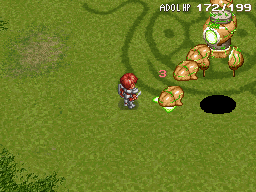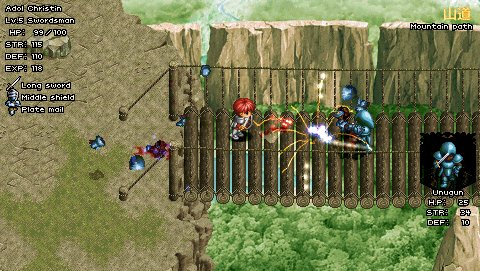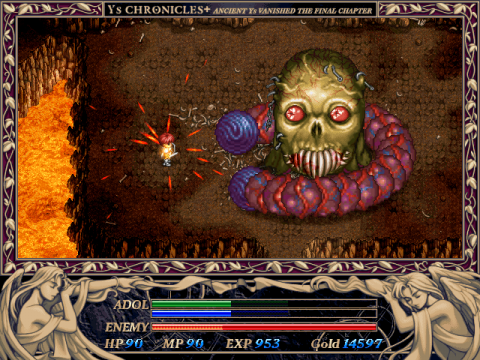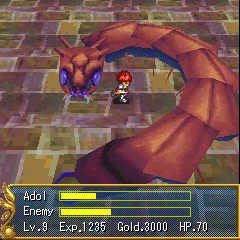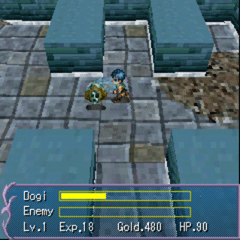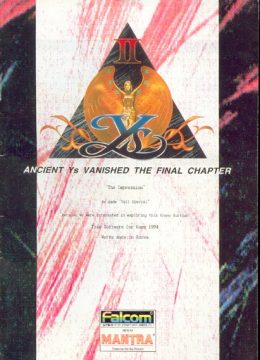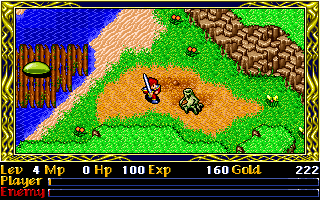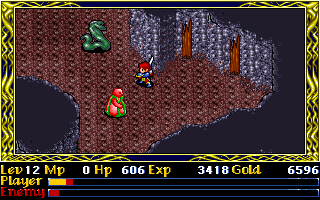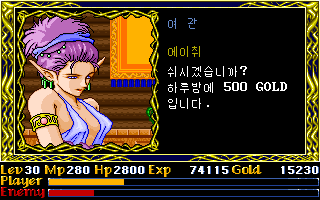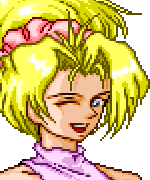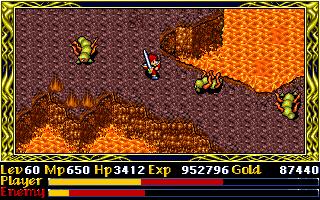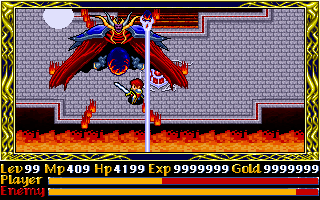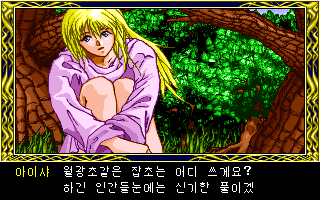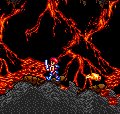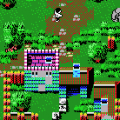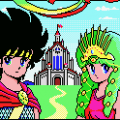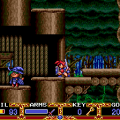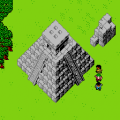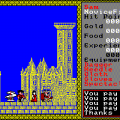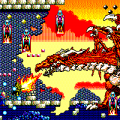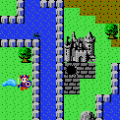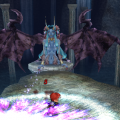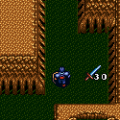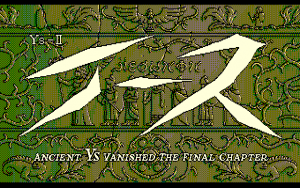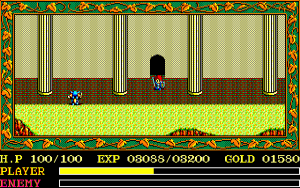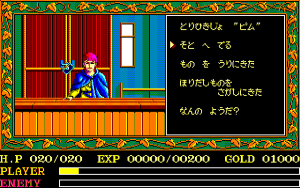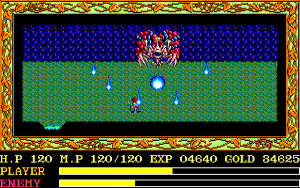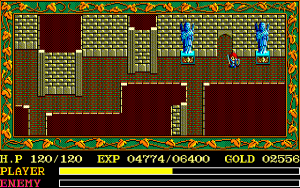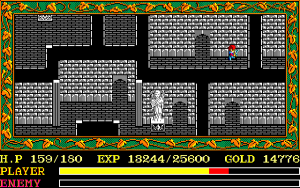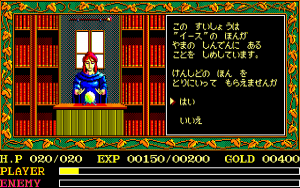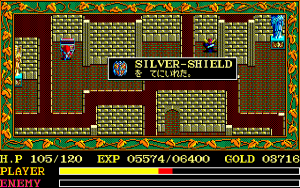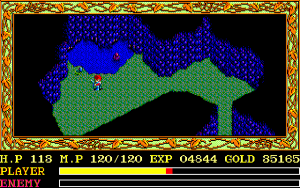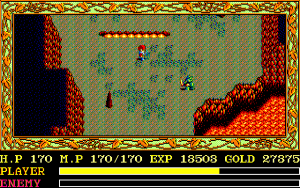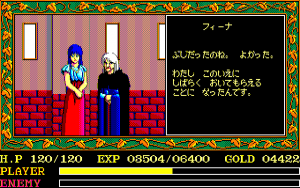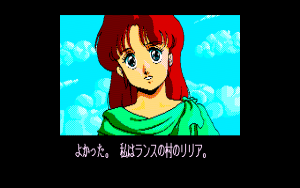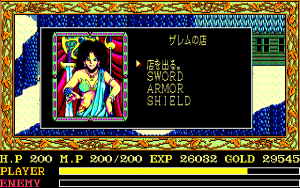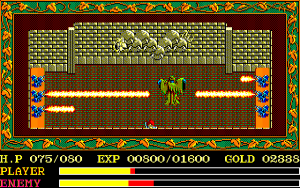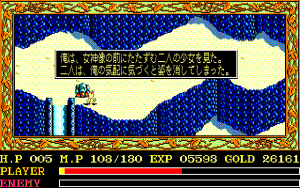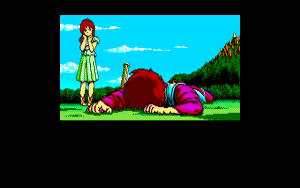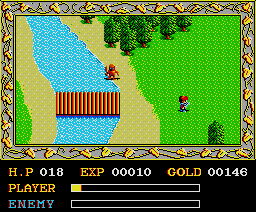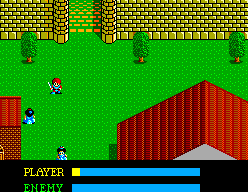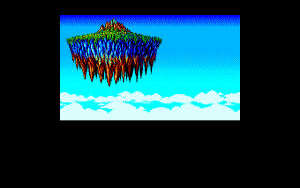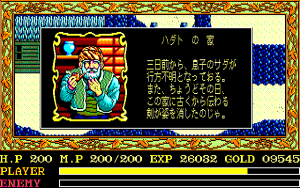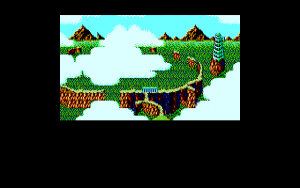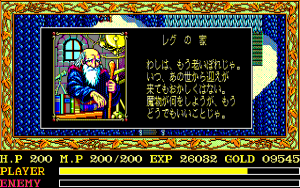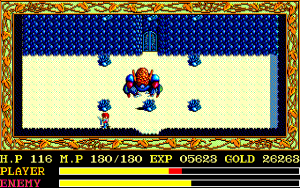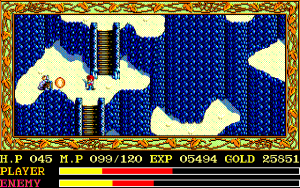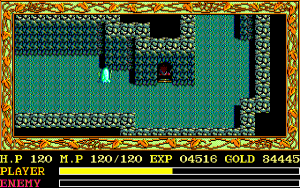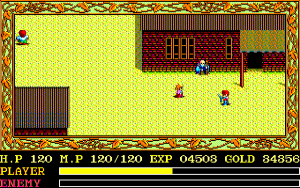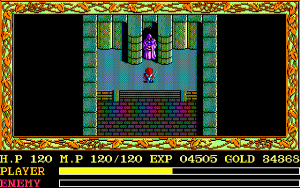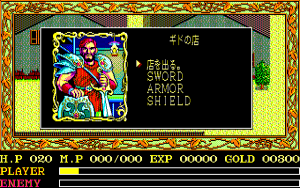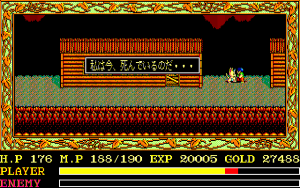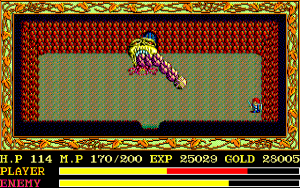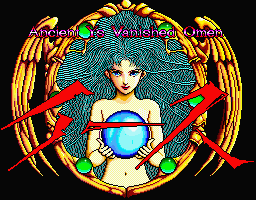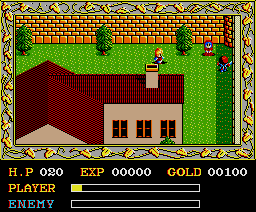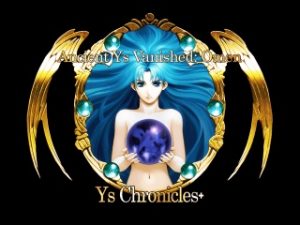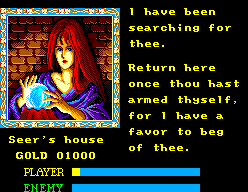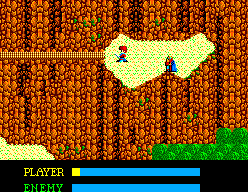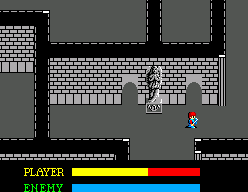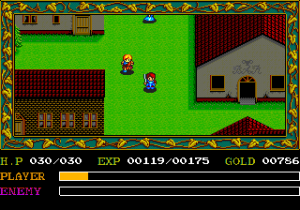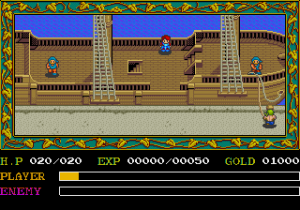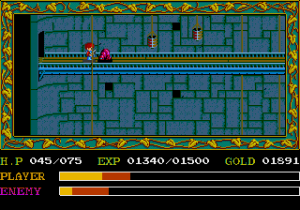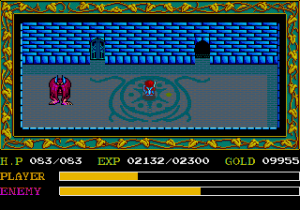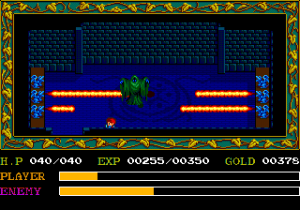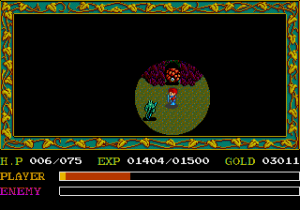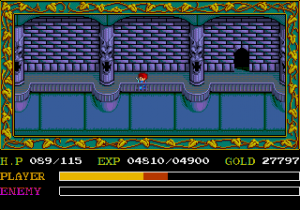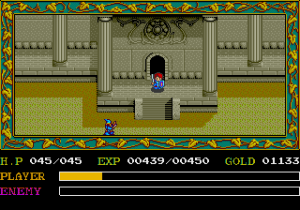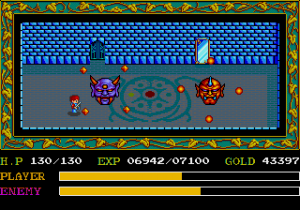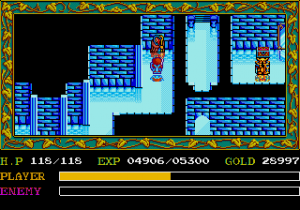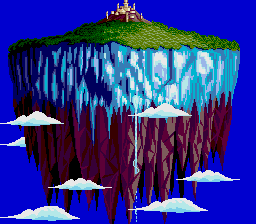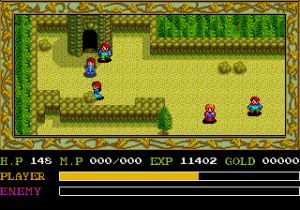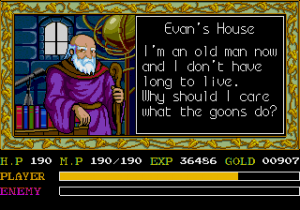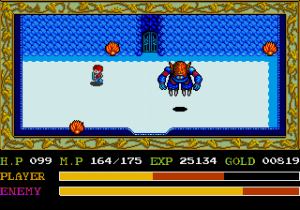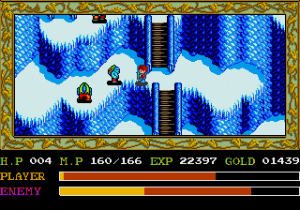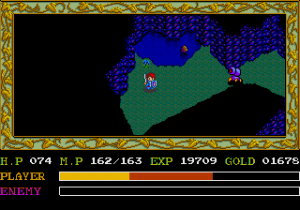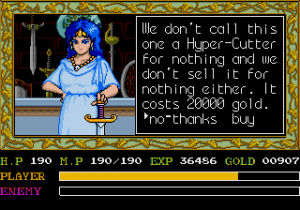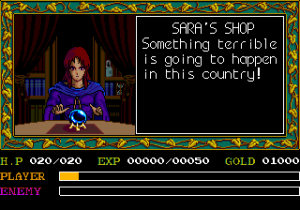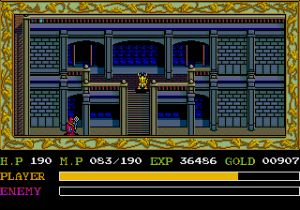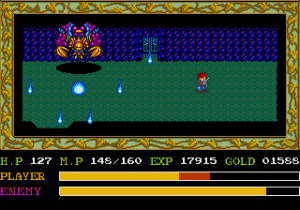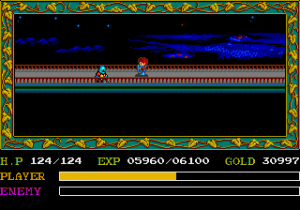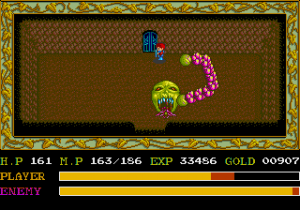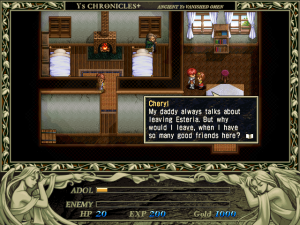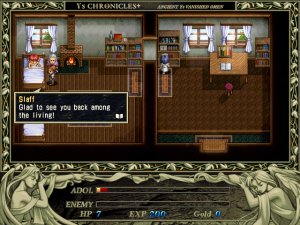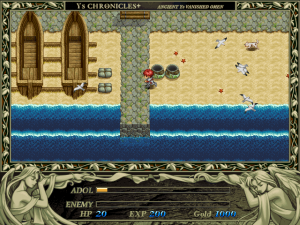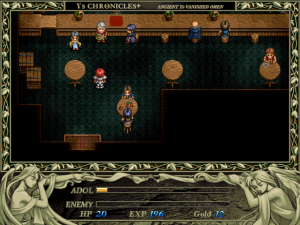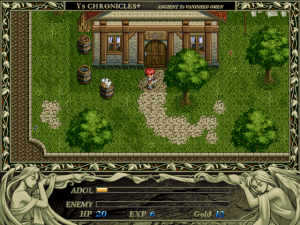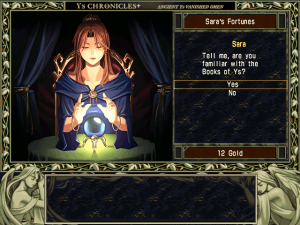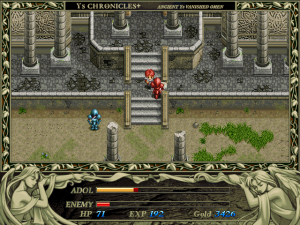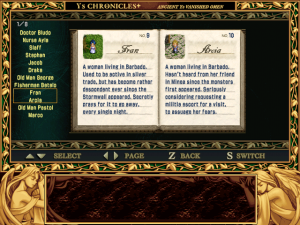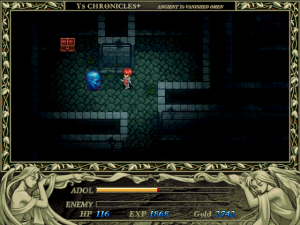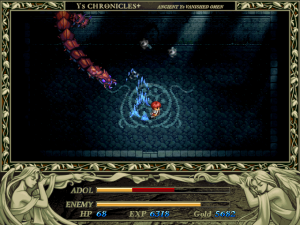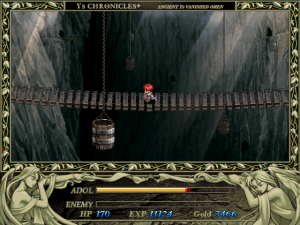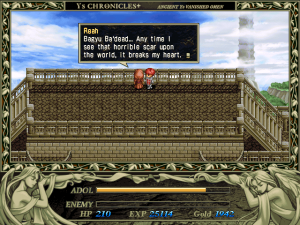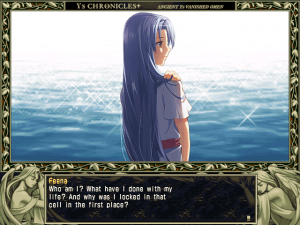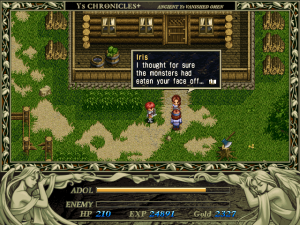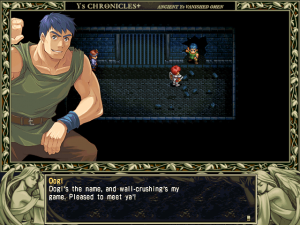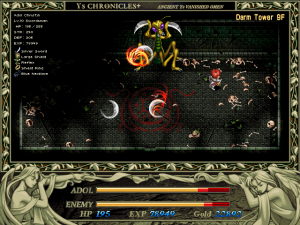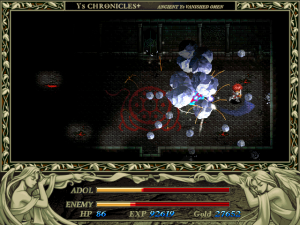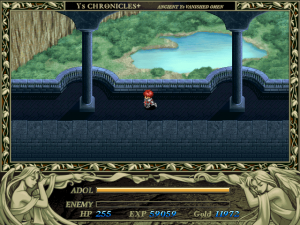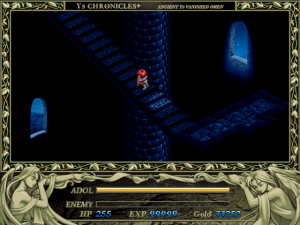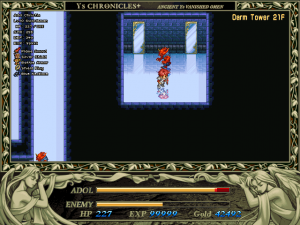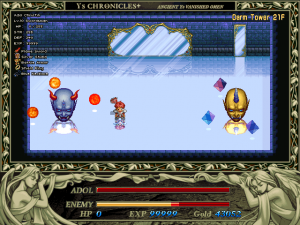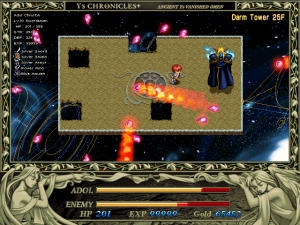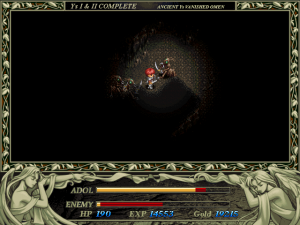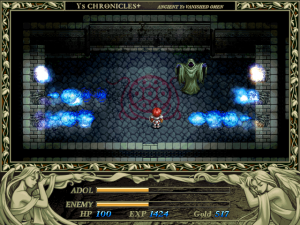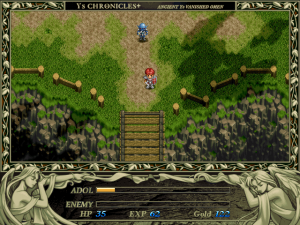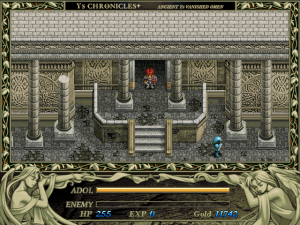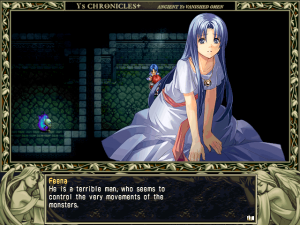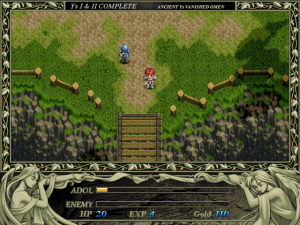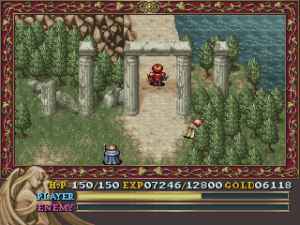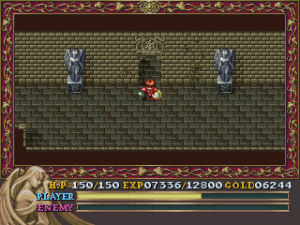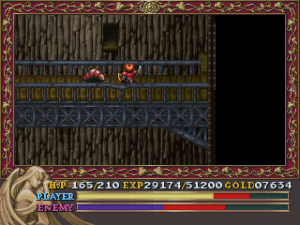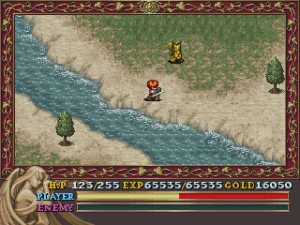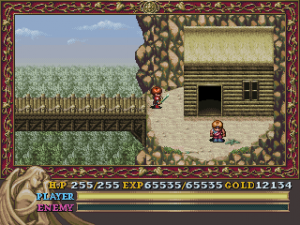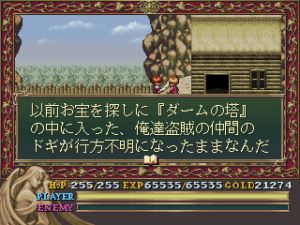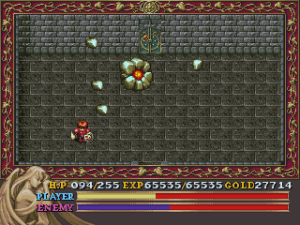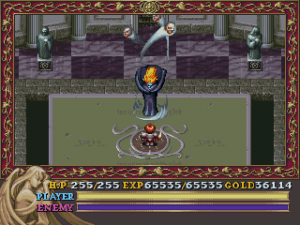- Ys Book I & II
- Ys III: Wanderers from Ys
- Ys IV: Dawn of Ys / Mask of the Sun
- Ys V: Ushinawareta Suna no Miyako Kefin
- Ys VI: The Ark of Napishtim
- Ys: The Oath in Felghana
- Ys Origin
- Ys Seven
- Ys: Memories of Celceta
- Ys VIII: Lacrimosa of Dana
- Lacrimosa of Dana (Novel)
- Ys IX: Monstrum Nox
- Ys X: Nordics
- Ys Strategy
- Ys: The Call of Solum
- Ys vs. Sora no Kiseki: Alternative Saga
- Ys (Anime)
In the world of action-RPGs, Falcom’s Ys series is something of an underdog. Despite being one of the most important computer RPGs in Japanese history, Ys the series never quite reached worldwide popularity in the way of Final Fantasy or even Dragon Quest. Maybe this is due to the burden of being saddled with a slightly unpronounceable name – it sounds like “ease.” Note that the title is not “Y’s” and there is no apostrophe, despite what some early marketing material may have indicated. Its full title – Ancient Ys Vanished Omens – is a grammatical quandary of tremendous proportions.
Or, more likely, maybe it’s because they never really appeared on mainstream systems in America – the original games were released on the Master System and TurboGrafx-16 CD. This has been changing in recent years, thanks to the efforts of XSeed, who localized several Ys titles for the PSP, PS Vita and PC platforms. Now, more players can learn for themselves what the Ys series is all about – fast paced action and adventure in faraway lands, and some of the best music in the history of all video gaming.
Adol Christin
The star of Ys is Adol Christin, red haired swordsman extraordinaire. With nothing but his fiery mane, mad sword skills and extreme wanderlust, Adol travels the world, uncovering ancient civilizations, aiding villagers in need, and generally being an all-around nice guy. Like so many Japanese RPGs, Adol almost never speaks directly, and in the games where he does, he’s not voiced, outside of some battle yells and grunts. In the very first home computer releases, his illustrations appeared still a bit coarse with rather brown-ish hair, but the first sequel already introduced his characteristic look. While the art style has changed over the years, the basic character design hasn’t.
The name Ys refers to a floating island in the sky, long removed from the soil to seal away some terrible evil. The first two games focus on the civilization and story of the flying continent, although later games send Adol off to other lands, only occasionally returning to its myth and lore. The continent of Eresia – where most of the Ys games take place – is based directly off Europe, sometimes very closely, other times more vaguely. Most of the early games take place around the area where France would be. The isle of Esteria from the first game might or might not exist – judging by its location it might be the Île d’yeu – but other games are set in various analogues to real places. Ys IV takes place in Celceta, which lies somewhere around the Spain/France border. Ys V takes place in Afroca, which is naturally Africa, and features the city of Xandria, which is Alexandria. In Ys VI Adol ends up in the Great Vortex of Canaan, which is essentially the Bermuda Triangle, with a bit of the Atlantis myth sprinkled in. Ys Seven takes place in Altago, the equivalent of Carthage. All throughout the series, Adol runs in with the somewhat evil Romun Empire, which of course is an extremely transparent allusion to the Romans. There was actually even a lost ancient city by the name of Ys, built near Brittany. While not floating in the sky, it was built below sea level, but surrounded by dams. As the story goes, the devil opened the gates and flooded the city, as punishment for its decadence.
Even though all of the games take place in different regions, with a largely different cast of characters, there’s a lot of continuity spread throughout the game world. For example, Dogi, an extremely minor character in the original Ys (he busts Adol out of a prison) ends up becoming one of the primary characters in Ys III, and keeps popping in throughout the series, eventually becoming a playable character in Ys Seven. One of the central “characters” of the first game is the Roda Tree, which converses with Adol and helps him on his quest. Throughout later games, you can find fruit from this tree. Similarly, in Ys II, Adol finds the Celceta Flower to cure Lilia – and actually visits the country of Celceta in Ys IV, where he also returns to Esteria and meets up with many NPCs from the first two games. The overarching storyline focuses on an angelic race known as the Eldeen, who mostly died off several centuries before the events of the games. It’s a little tough to follow though, considering that, due to assorted games in the series being remade numerous times, there are a substantial number of retcons.
Dogi
Dogi is the most frequently reoccurring supporting character. A minor character in the first game – the thief who saves Adol from the dungeon – he becomes more important in Ys III, as he leads Adol to his home town of Redmont. His role in all of the Ysgames is pretty much just to break through stone walls, earning him the nickname “Dogi the Wallcrusher.” This skill is useful, because he often ends up saving Adol in the process. He was named Colin in the US TG-16 release of Ys Book I & II.
The Ys storylines are rarely very elaborate, but they are fun, in the classical sense. Adol adventures to a new land, where his reputation as a red-haired swordsman precedes him. Eventually he uncovers a lost civilization, along with assorted evil characters that wish to use their long lost magic and/or technology to rule/destroy the world. There are other recurring themes throughout – Adol getting shipwrecked, Adol getting tossed into prison and having to be saved by Dogi, and Adol attracting a young woman, whom he typically pays little attention to. The Ys girls are much like Bond girls, discarded and unremembered in each passing installment (with the exception of Lilia, who makes it through a couple sequels) but it’s an amusing recurring element nonetheless.
From a gameplay perspective, Ys differentiates itself from practically all other action-RPGs with its combat system – or, it could be said, the apparent lack thereof. Adol is far too badass to rely on an attack button. Instead, he kills bad guys simply by ramming into them. This might seem stupid at first, but there’s a bit of technique to it. Adol can’t just blaze into bad guys head-on, as this will cause him to end up quite dead. Instead, he has to hit them off-angle. This can be somewhat difficult to do, because most of the early versions only support walking in the four cardinal directions.
Certain games in the series are pickier on this aspect than others – the early PC games often require to aim precisely to avoid taking damage, while the 16-bit titles tend to be more lenient. Nevertheless, success mostly depends on Adol’s strength level. This means spending a majority of the time running around the landscape, plowing through bad guys like an invincible roving wall of destruction and collecting their luscious experience points. Since attacking enemies properly can be a bit difficult at first, the games grant a bit of leeway by letting health regenerate in outdoor areas, as long as Adol stands still. However, once he enters a dungeon, he’s pretty much on his own, relying only on what small amount of healing supplies he can bring.
It may all sound overly simplistic, considering much of what one does is to roam the landscape, ramming into every enemy in sight, but that’s really part of the fun. Ys doesn’t bog itself down with puzzles or aimless wandering. For the most part, they’re straightforward, no-nonsense adventures that are usually fairly short (by RPG standards) but still full of the same sense of wonder and adventure that have made the Zelda games so consistently popular.
While the graphics seem simplistic – and they are, in the older games – back in the day, the character artwork in the shops was simply amazing. The TurboGrafx-16 version was one of the first games released on the CD platform, and was a fine introduction to show off some impressive anime-style cutscenes. Another major trademark of the series – the action taking place in a decorated window frame – was ditched for later games. While it added an interesting feel, the actual playing field ended up rather cramped.
Ys began its lineage on the Japanese home computer PC-88. spreading to other computers like the MSX2, FM-7 and X68000, and eventually received ports to almost every major console. Almost every new entry in the series mixes up the concept a bit: Ys III departed the furthest from the other games by shifting to a side view, but both of the initial versions of Ys IV (there were two entirely separate games released around the same time, plus two remakes later that shake things up even more) brought the classic overhead view back into play. Ys V drastically changed the formula by actually giving Adol an attack (and jump) button, while Ys VI brought the series into 3D, sort of. Finally in Ys Seven, Ys: Memories of Celceta, and Ys VIII, Adol gives up his lone wolf status, as players take control over a party of three characters, fighting on the field at the same time. For a series that’s over three decades old, it’s come a long way.
The primary developers were Masaya Hashimoto, the director, programmer and game designer, and Tomoyoshi Miyazaki, the scenario writer. They had previously worked on the two Asteka adventure games for Falcom, before shifting gears to an RPG. The duo worked on the first three Ys games until they departed the company to set up their own company, Quintet, known for SNES games like Actraiser and Illusion of Gaia.
Ys (イース): Ancient Ys Vanished Omen / Ys: The Vanished Omens / Ancient Land of Ys / Ys I Eternal (イースI エターナル) – PC-88, PC-98, X1 Turbo, FM-7, MSX2, IBM PC, Apple II GS, Famicom, Master System, X68000, TurboGrafx-16 CD, Saturn, Mobile, Windows, PlayStation 2, Nintendo DS, PSP, Wii, Android, iOS (June 21, 1987)
Ys II (イースII): Ancient Ys Vanished The Final Chapter / Ys II Eternal (イースII エターナル) – PC-88, PC-98, X1 Turbo, FM-7, MSX2, Famicom, TurboGrafx-16 CD, IBM PC, Saturn, Mobile, Windows, PlayStation 2, NDS, PSP, Wii (April 22, 1988)
The original Ys game begins with Adol in the country of Esteria, where he has to uncover the mystery of the vanished land. With the help of a mysterious fortune teller, Adol begins to learn of six priests and two goddesses who ruled the land of Ys. Apparently by uniting the books left by the priests, one can unlock the secrets of the floating continent. Not only that, but a number of unfortunate things are happening, what with all the monsters running around, reports of a mysterious, black-cloaked man and the cryptic shortage of silver artifacts. Naturally, it’s up to Adol to investigate.
Along the way, you’ll run into the descendants of the priests, discover the goddesses, and find just why there’s a gigantic crater in the middle of the island.
Ys I Characters
Sara
The fortune teller who first gets Adol started on his journey to find the six books of Ys. She is killed off halfway through the game, at least in the original game and Falcom’s later remake. In the TurboGrafx-16 version she is merely kidnapped, although Adol still never sees her again. Her family remains prominent in Esteria, though: Her aunt Jeba lets Feena stay at her home after the goddess is freed from her prison, and her cousin Goban leads the local gang of chivalrous thieves.
Luta Gemma
In the original Ys I, he first appears fairly late in the game – Adol meets him in the prison cell in Darm Tower, where Luta, or Luther, helps him through some traps and puzzles. Ys Eternal enables players to make themselves acquaintaned with him earlier, by rescuing him from a monster attack in the field. As descendant of a Priest of Ys, he returns for the second game’s finale.
The first Ys game is incredibly short. There’s only a tiny overworld, two towns and three dungeons. The biggest flaw is the sheer amount of backtracking one has to do. Sure, it’s not a huge world, but a lot of time is spent running back and forth between towns, gathering and using items necessary to unlock the next part of the quest. There are a few bosses, but they are rather annoying, as even hurting them usually requires a substantial amount of grinding, and then they quickly become too easy. It’s also hard to tell where their weak spots are, so it’s a crap shoot of whether you’ll hit them or take damage yourself. The final fight is incredibly cool though, taking place above a flying starfield as bits of the floor tiles drop away. And the final dungeon – a 25 floor behemoth of a building, called Darm Tower – is so huge that it takes up nearly half the play time of the entire game. Which, all in all, is really only about four or five hours.
Combat is also still a bit too simplistic – aside from the usual ever stronger swords, shields and armor, the only modifying element to add some tactical choice are several magical rings Adol can find. These may increase his attack or defense, allow him to regenerate health inside the dungeons, or make all the enemies slower. Secondary items are sparse, mostly just items used for ferrying about to other characters. The only really useful one being the Mask of Eyes, which turns the view to gray and allows Adol to see secret doors, but makes enemies invisible instead.
As a whole, Ys I just feels like a prelude to the real game – Ys II: The Final Chapter, which is, of course, far from being final.
Ys I & II are so closely intertwined that they’re often bundled together as a single game. They use the same basic gameplay systems, after all, and the ending of Ys I, where Adol is teleported to the floating continent, is essentially the intro to Ys II.
Ys II actually takes over just after Adol defeated the evil Dark Fact, found all six books, and was transported to the floating continent of Ys, where civilization still lives and prospers. Adol begins his journey through the ancient land, uncovering more of the mysteries of the six priests, and discovering (and eventually defeating) the evil that had been contained therein. The introduction of the computer version was one of the most impressive cutscenes that gamers had seen in 1988.
Ys II Characters
Lilia
Lilia finds Adol lying in the field after he is catapulted through the sky. Although she is quite kind, she is also tragically unaware that she has a terrible illness that will kill her any day. After Adol repays his debt by finding the cure, Lilia develops a hilariously overbearing crush that’s powerful enough to bleed into the later games. She is not a goddess of Ys, although she is extremely inconvenient, in that all she really does is get kidnapped.
Dalles
The cloaked leader of the demon army, who conducts gruesome human sacrifices in the temple, and makes it his personal goal to challenge and mock Adol, whom he considers a surprisingly worthy opponent. He also appears in Ys Origin. In some versions he looks like the Grim Reaper, other times his appearance is more human. His alternate spelling is Duless.
Darm
While his henchman Dalles does most of the dirty work throughout the game, the true enemy in Ys II is Darm (or Dahm, depending on the translation), who either wears or chiefly consists of an incredible mask. (Unlike all the others, his image is from the TurboGrafx-16 version, not Ys II Chronicles.)
While extremely similar on the surface, Ys II is much more fleshed out than its predecessor. It’s much longer, for starters. Outside the initial village of Rance, Adol explores the Ruins of Moondoria, the Sanctuary of Toal, the Rasteenie Mine, the Ice Ridge of Nolta, the fiery Moat of Burnedbless, and expansive Solomon Shrine. It’s a little more linear given that there’s not really an overworld area, but there are more than two towns, and so there are more folks to talk to.
The biggest addition are the magic spells. With the flame spell, Adol can actually attack from a distance, making the whole battle system feel less arbitrary. The boss battles have been fleshed out considerably as well: They’re more reliant on player skill and also allow a slightly underleveled Adol to succeed, making them less frustrating. That doesn’t mean that the latter few aren’t ridiculous fireball sponges even after a lot of grinding, though. Thankfully, it’s also possible to walk out of most boss fights if things get too heated, but afterwards the enemy is back at full health.
Far and away the coolest spell is Transform (called Telepathy in some versions), which turns Adol into a happy little red haired demon. Not only is he invincible to monsters, but he can actually converse with them, discovering clues and their true feelings about being a bad guy in a video game. He even uses it as a fair bit of trickery, invading enemy compounds, while all of the guards chatter about some intruder. Admittedly, some of the mazes are somewhat irritating – the Rasteenie Mine, taking place in a gigantic series of interconnected rooms, is a bit annoying, especially considering it’s the first area of the game. But otherwise, it’s an excellent evolution of everything the first game was.
Both Ys titles originally came out on several Japanese computer systems, including the PC-88, PC-98, Sharp X1, FM-77AV and MSX. The PC-88 and PC-98 versions are similar, with the latter having slightly better sounding FM synth and better color depth. The X1, FM7 and MSX versions are all basically the same, with lower resolution but cleaned graphics, and PSG sound. The music for the original versions was composed by Mieko Ishikawa (who stays with the series as “coordinator”) and Yuzo Koshiro. The first game also made it to America for the IBM PC and Apple IIgs courtesy of Kyodai. The English names are also entirely different, with Adol being renamed Arick. Unfortunately the IBM PC version only supports internal speaker sound, so the effect of the excellent music is lost. Other than graphical and audio differences, the early computer versions are mostly similar. The gameplay is slow, the balance is off, and you need to spend a lot of time grinding.
Ys first hit the consoles for the Famicom in 1988, with Ys II following 1989. Some of the maps have been drastically redesigned in both games and there’s some extra music as well. Ys II also speeds up the gameplay quite a bit. Ys I has an extra quest on the overworld involving statues that can teleport you, and a second form of the final boss. Some of the old bosses also feature different attack patterns than the originals.
The Sega Master System game was the first to come out in America, under the title Ys: The Vanished Omens. Here the gameplay speed more matches the computer versions. Some of the dungeon maps have had their layout mirrored, and like the Kyodai version, there’s some weird translations in the English version, as the hero Adol is known as Aron. The game box also spells the title as Y’s with an apostrophe, which isn’t correct.
The 16-bit generation of Ys games began with a port to the TurboGrafx-16 CD, published by Hudson and developed by Alfa Systems. This was translated into English and released in North America as one of the system’s flagship titles. The first two Ys games are combined into one big adventure, with stats carrying over from one game to the next, as well as a few additional scenes (like Adol getting off his ship at the beginning of the game) and more anime style artwork. While the overhead graphics are still generally unimpressive and the scrolling is a little choppy, the CD music really makes the game shine. Despite all of the future remakes of the first two Ys games, the TurboGrafx-16 version still contains the best arrangements of these songs. Many of these were taken or rearranged from the Ys Perfect Collection CDs, which was done by Ryo Yonemitsu. There’s also a fair bit of voice acting, which is competently done compared to the other English games that came out for the system.
The gameplay speed has also been ramped up quite a bit, which jump kicks the game’s originally slow speed. To compensate for the juiced up pace, the hit detection in combat is less fussy. Dying has been made less frustrating by the addition of check points, instead of forcing players to restart or load a saved game like earlier versions did. Due to the rebalancing, level ups have less of an impact, but occur much more frequent, making the grinding feel a bit more rewarding. Until the Eternal versions came out, this was widely considered the definitive variant of Ys, and can still be found as a download on the Wii Virtual Console.
Only the first Ys came out on the Sharp X68000 computer in 1991, developed by Dempa, and much like the Famicom ports, it takes a lot of liberty with the maps, redesigning many of them. Some of these decisions are a little weird, as the field is almost entirely gone, reduced to a tiny forest path from the first town to the second. This is one of the only versions to have realistically proportioned character graphics. It uses a weird CGI-like art style for the sprites, and some really creepy artwork for the shopkeepers. Still, the high res graphics are quite nice looking, and the game even uses a modified sprite for all of Adol’s equipment options, a feature otherwise only found in the much later Saturn version.
Though the soundtracks to most versions are identical, certain versions include exclusive pieces of music. The Famicom version features several new songs, including a separate song for Zepik Village, a new track for the lowest level of the temple, a track for the mountain path, and an extra final battle track. The X68000 version includes two new tracks, including another completely new song for Zepik Village. The MSX/X1/FM7 port has a number of exclusive tracks too, including some new ending songs. A full listing of the tracks and where they’re used can be found at Ys Music Files.
A few years down the line, JVC published two Falcom Classics compilations for the Saturn. The first package, released in 1997, contains a remake of Ys, alongside Xanadu and Dragon Slayer. The graphics obviously look a lot more detailed, but they’re all a bit drab compared to the bright palette of the TurboGrafx-16 game, despite some nice new character portraits. The music, despite being redbook, also pales greatly in comparison, with very MIDI-esque arrangements. There’s no voice acting or even much of an intro. But while the presentation screams “budget title,” the gameplay has at least been suitably beefed up. While it takes a long time to level up (like in the old computer versions), Adol can finally run, as well as move diagonally. These small gameplay enhancements almost, almost make it better than the TurboGrafx-16 version. As a bonus, a certain version of the Falcom Classics bundle comes with an additional CD. It contains a CD drama, as well as a video of one of the voice actresses taking a tour of the Falcom store in Japan (and losing terribly at a game of Ys).
The second Falcom Classics package was released in 1998, featuring a remake of Ys II, as well as Asteka II: The Temple of the Sun. It seems like JVC put a bit more effort into this one – there’s some voice acting, as well as an anime intro, and even scenes from the original Ys game with voiceovers, as if the publisher was trying to make an apology for the previous release. Otherwise, the enhancements are pretty much the same: more detailed graphics but less vibrant, and mediocre arrangements of the music. The second CD included with the limited edition simply has some music selections from Ys II and Asteka, since they aren’t redbook on the game CD.
While the Saturn versions are passable, they never quite lived up to their potential. Later in 1998, Falcom brought to the original Ys game back to the computer, this time for Windows 98. Under the name Ys Eternal, this isn’t just yet another port, it’s practically a complete remake. All of the graphics have been redone in high-res (at the time meaning SVGA 640×480), with lots of nifty little added effects – you can see little sword swishes when Adol attacks, and enemies don’t just blink and disappear when they die – they splatter and fall apart in a cloud of blood and dismembered limbs. Cats, dogs, birds, crabs and other critters around the settlements do a great deal in making the world of Ys feel more alive. The new character artwork is all spectacularly gorgeous as well.
But the real appeal is just how much expanded the game is. Instead of beginning in the town of Minea, Adol is washed on shore in the entirely new town of Barbado. There’s a lot of extra characters (and a few minor subquests), and while it feels a little tacked on, it’s nice to see the original game expanded. The overworld is now much, much larger as well, with a lot more to see and do. There are a couple of minor additions too, like having to guide Feena out of her prison below the shrine, and plenty of Easter eggs. Alas, in spite of the expansions, it’s still quite a short game. And unfortunately, there’s no voice acting here either. The music consists of several new MIDI renditions, some of which are extended quite a bit. They’re far better than the Saturn version, but still not quite as good as the TurboGrafx-16 soundtrack or the Perfect Collection CDs.
Falcom published Ys II Eternal in 2000, with the same enhancements and even more detailed graphics. Since Ys II is a much longer game to begin with, the expansions aren’t nearly as noticeable as they are in the original. However, the battle system has changed drastically. You no longer need to worry about hitting your enemies straight on – ram into them and you’re guaranteed to hurt them. Instead, enemies will blink every couple seconds and take a swipe at you – all you have to do is avoid those attacks. The bosses have also been redone to look absolutely amazing. In the towns, every single NPC is now referred to by name, and the game keeps a log with short descriptions of the people.
In 2001, Falcom bundled both Eternal games, enhanced the graphics on the first title to make them match the brilliance of the second, and released them together under the name Ys I & II Complete, this time with a fully animated intro. For the first time players could chose from several difficulty settings to remedy the grinding issue at least partly. Also new is a time attack boss rush. The limited edition of this set came in a classy package designed like an ancient book, with gold letters on the cover. While the plans to release this package in America fell through, a fan translated patch eventually made the games playable in English and on non-Japanese Windows systems.
It’s interesting to note that the original PC88 version of Ys had several unused pieces of music, which were included in the sound test and released on the official soundtrack album. The introduction to the Turbografx-16 song, “Theme of Adol”, was based off one of these previously unused tracks. Ys Eternal reused some of these tracks at different parts of both games too – “Chase of Shadow” and “Dreaming” are used in Dark Tower in Ys I to break up the monotony a bit, and “Battleground” is used in the shrine in Ys II. The song “Tension”, which was only in the MSX, X1 and FM7 version, was also incorporated into Ys I.
Perhaps feeling that console gamers had been neglected long enough, Digicube brought the remakes to the PlayStation 2 under the title Ys I & II Eternal Story. It’s a pretty straight port of the Windows version for the most part, with the graphics coming through remarkably well on a television screen. There’s an additional mode that rebalances the level up system, although it doesn’t combine the games like the TurboGrafx-16 version. There’s also a bonus “Dream World” where you can meet two additional characters named Misha and Jeanne. It’s really just a fancy front end for an artwork gallery and a sound test, although there are a few minor subquests that unlock stuff in this mode. A few minor changes have been made to the weapon system, though. Normally, whenever Adol gets a new piece of equipment, the old one becomes entirely useless. Not so here – each weapon has its own unique attribute. For instance, the Short Sword can be used to stun powerful enemies, leaving them vulnerable to be finished off with a more powerful weapon. Switching between weapons is as easy as pressing the shoulder triggers. It’s not a gigantic addition, but it adds a tiny bit of depth to the combat.
Other than that, voice acting has been added once again, although the MIDI arrangements for the music are still there, and the instrumentation isn’t quite as good as in the PC version. The only other real problem is the annoying amounts of load time. NEC Interchannel was going to bring this to America, but apparently Sony rejected it. The company went on to publish just two games – Culdcept for the PlayStation 2 and Tube Slider for the GameCube – before closing up their American division.
 These Eternal ports were used for the basis of Nintendo DS versions of the two games, released separately by Interchannel in Japan in 2008, and bundled together on the same card by Atlus in America in 2009. While all of the sprites are still in 2D, the background graphics have been changed to 3D, and very bad 3D at that. It’s quite pixellated, but at least the game moves quickly. The problem is that the screen is zoomed in so far that it’s hard to see the surrounding areas, and the map on the lower screen isn’t as useful as it should be. Also, the battle mechanics have changed a bit, too. In order to attack, to have to hit the “sword” button right before you collide – the angle of attack doesn’t really matter so much as your timing. It’s not bad, but it takes a bit of getting used to. You can also play with the classic “bump” mechanic, but only if you’re using the stylus controls, which work terribly. (It’s possible to simulate it with conventional controls by not wielding a weapon, but of course that reduces attack power.) Ys II introduces a multiplayer mode, a first for the entire series, in which players fight for orbs dropped by monsters.
These Eternal ports were used for the basis of Nintendo DS versions of the two games, released separately by Interchannel in Japan in 2008, and bundled together on the same card by Atlus in America in 2009. While all of the sprites are still in 2D, the background graphics have been changed to 3D, and very bad 3D at that. It’s quite pixellated, but at least the game moves quickly. The problem is that the screen is zoomed in so far that it’s hard to see the surrounding areas, and the map on the lower screen isn’t as useful as it should be. Also, the battle mechanics have changed a bit, too. In order to attack, to have to hit the “sword” button right before you collide – the angle of attack doesn’t really matter so much as your timing. It’s not bad, but it takes a bit of getting used to. You can also play with the classic “bump” mechanic, but only if you’re using the stylus controls, which work terribly. (It’s possible to simulate it with conventional controls by not wielding a weapon, but of course that reduces attack power.) Ys II introduces a multiplayer mode, a first for the entire series, in which players fight for orbs dropped by monsters.
The music isn’t quite up to par with the PC release, but it’s actually slightly better than the PlayStation 2 version. There’s a new stage added to Ys I – Bagyu Ba’dead (aka Vageux-Vardette, Bague Badet and Clifton’s Cliff), the crater where the floating island used to reside, which you visit in order to search for Sarah after exploring the temple. It’s short, but features a new boss. Otherwise, there’s not much new content – the rest of the artwork and movies are straight from Ys Eternal, although it’s missing the extra characters from the PS2 port. Both releases are a bit janky, but not terrible, and it’s the first time Ys I & II had seen official releases in English since the TurboGrafx-16 CD days, even if the translations done by Atlus aren’t quite consistent with other releases. (The Palace of Solomon is known as the Palace of Salmon, Dr. Flair is Dr. Fleah, etc.)
Falcom went and outdid themselves in 2009 by releasing Ys I & II Chronicles for the PSP. This is yet another port of Ys I & II Complete, although it’s much better than the DS version, especially since it’s not only entirely 2D, but includes both games from the get go. The interface is redone so the map takes up the whole screen, and there is an option to play with brand new character artwork, but otherwise, it is pretty much the same as the PC version. (It doesn’t include the extra area or boss from the DS version, nor the Dream World from PlayStation 2.) The coolest option is the ability to switch between three soundtracks: the original PC-88 FM synth music, the version from the original 1998 Eternal release, and a brand new set of arrangements done by Yukihiro Jindo, who did a similar revamp on Ys: The Oath in Felghana. They’re fantastic renditions and proudly stand up next to the TurboGrafx-16 versions in quality.
This was ported back to the PC and released by XSeed under the name Ys I & II Chronicles+. It supports both 4:3 and 16:9 modes, and is smoother than the the PSP version. It’s also notable for finally allowing to buy the PC version officially in English. A different PC version of Ys I & II Chronicles was released in Japan, but it’s a lazy port that just takes the PSP game, cramped resolution and all, and sticks it on the computer.
Like many veteran Japanese software houses, Falcom is rather fond of bringing their franchises to the mobile sector, and there have been at least five different cell phone ports of Ys I. A first, low-res version of Ys Eternal was released late in 2002, published by a company named Cybird. Only half a year later followed another interpretation by Hudson, which is the only one based more closely on the old computer versions, and even followed up with the sequel. Then during the summer of 2004, Bothtec came up with yet another version, based on Ys I Complete.
Then, Falcom teamed up with Taito and contract developer Barnhouse Effect, to bring both episodes as Complete versions. The first game was obviously based off the Bothtec release, but replaced the pixel art sprites for Adol and the monsters with some that look downsampled from the PC version. The same cooperation also brought about Shin Ys I 3D, a polygonal reimagining of the first game, and Adventure of Dogi, where Japanese players could hit the dungeons as Adol’s reoccurring companion.
Then, in 2015, Dotemu ported Ys Chronicles to iOS and Android platforms, with the first and second games released separately. The first uses a brand new, rather poor translation, while the second wisely licensed the XSeed translation.
Ys II Special (이스2스페셜) – IBM PC (1994)
In 1992, Korean company Mantra obtained the rights to bring Ys II to IBM PCs. It took more than two years to get this version done, but it was more than just a mere port, as Mantra drastically redesigned and expanded the game into something completely new and unique. In fact, it’s far more fleshed out than even Falcom’s own remake Ys II Eternal. The promotional artwork was done by manwha artist Lee Myungjin (Ragnarok, Eojjeonji… Jeonyeok). Naturally, all of the text is in Korean, so for Western gamers it’s hard to figure out what’s going on.
The plot takes elements from Falcom’s game as well as the Ys II anime, so Adol has to save Lilia from getting sacrificed at the beginning instead of finding her some medicine. There is a ton of entirely new content as well: Instead of visiting all the shrines for the six priests in the first dungeon, the structure of the quest is now more akin to Ys IV on the PC Engine. Every priest now got an own tower with a “Dark” form as the boss. The snow plains are now a sealed exile where criminals are sent, which means that it leads to a city of thieves, one of the new settlements. There is even a super secret new dungeon called, Dangun’s Tower, where the mythical founder of Korea hands Adol the most powerful set of equipment.
Some of the mechanics have changed slightly. There’s now a sword button, although it’s still possible to ram into enemies if Adol’s level is high enough. Special items are now required to regenerate health or save the game anywhere, before finding them this can only be done by staying at an inn. Adol is sent back to the beginning of an area if he gets killed, so it’s not totally unforgiving. All of the maps have been completely redone, with much longer dungeons and bigger field segments. There is actually an area to explore in between the village and the ruins at the beginning of the game.
Some extensions seem to be there just for the sake of extension, though – the trinity of Sword, Armor and Shield is appended with a slot for Gauntlets, which does nothing but further boost the defense stat. Numbers in general get much higher, and Adol can be powered up to level 99. Towards the end the areas also become larger and duller. Some are also intentionally designed to be particularly annoying – it’s not unusual to notice on the 17th floor of a dungeon that one has missed an important key on the first one (without knowing it’s the first floor, of course, forcing you to comb through all 16 floors in between). The game also seems a bit confused about the world view of the Ys series, so it introduces more typical fantasy elements like elves and dwarves.
Characters
With all of the extra maps, there’s a bunch of new songs, and they’re just as excellent as the tunes Falcom composed – Kwon Goohee Kwak Dongil from team soundTeMP worked on the soundtrack. It’s too bad they never got rearranged or used in any other versions. The graphics are entirely new, although they closely resemble the PC Engine version of Ys IV.
It’s quite a good game, and could possibly have been the best version of Ys II, except for one major problem – the bugs. Crashes are common, and there’s even a point where progress is made impossible without using the item that allows saving everywhere – which can be easily missed and is not possible to backtrack to from the point in question. A CD version was planned to add voices and redbook music, although it never came to fruition. Neither did a tentative similar treatment by Mantra for Ys IV.
